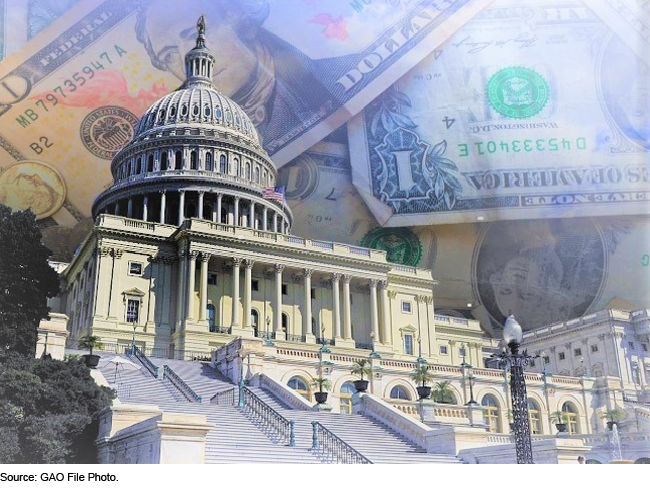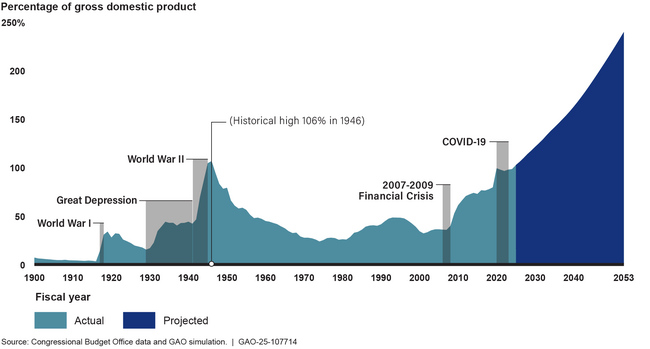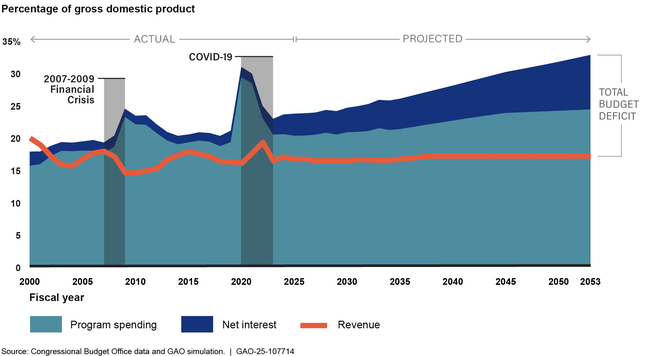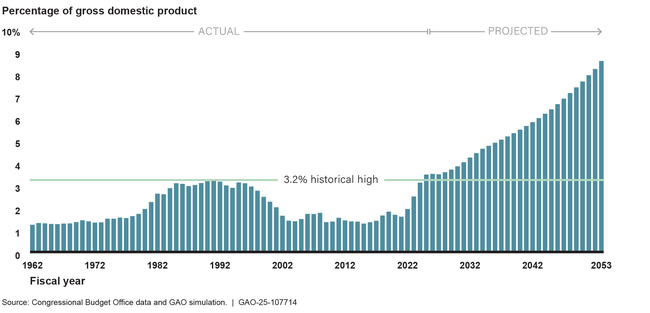The Nation's Fiscal Health: Strategy Needed as Debt Levels Accelerate
Fast Facts
The federal government is on an unsustainable fiscal path that poses serious economic, security, and social challenges.
We reported that:
As of September 30, 2024, publicly held debt was $28.2 trillion, or 98% of the size of the economy
Publicly held debt is projected to grow more than twice as fast as the economy, reaching 200% of the size of the economy by 2047
Government spending on net interest in FY 2024 exceeded federal spending on Medicare and national defense, and is projected to keep growing
We continue to recommend that Congress develop a strategy to inform the difficult policy choices in addressing our unsustainable fiscal path.
For more information on federal debt, see our resource: How Could Federal Debt Affect You?

Highlights
What GAO Found
The federal government is on an unsustainable fiscal path that poses serious economic, security, and social challenges if not addressed. Congress and the administration will need to make difficult budgetary and policy decisions to address the key drivers of federal debt and change the government's fiscal trajectory. The sooner actions are taken, the less drastic they will need to be.
Debt Is Projected to Grow Faster Than the Economy Over the Long Term
As of December 31, 2024, debt held by the public was $28.7 trillion. GAO projects that under current revenue and spending policies, debt held by the public will
- reach its historical high of 106 percent of gross domestic product (GDP) by 2027 (1 year earlier than GAO projected last year), and
- grow more than twice as fast as the economy over a 30-year period and reach 200 percent of GDP by 2047 (3 years earlier than projected last year).
Perpetually rising debt as a share of GDP is unsustainable. It has many direct and indirect implications for the economy, American households, and individuals. Risks include slower economic growth and increased chances of a fiscal crisis.
Debt Held by the Public Projected to Grow Faster Than GDP

Debt Levels Are Driven by Increasingly Large Annual Deficits
When the government spends more than it collects in revenue, it borrows from the public to finance the resulting deficit. Despite strong economic growth, the fiscal year 2024 deficit was $1.8 trillion, the fifth year in a row of a deficit above $1 trillion.
The deficit is composed of two parts:
- The primary deficit—the gap between program spending and revenue—which was about $950 billion in fiscal year 2024.
- Net interest spending—primarily the cost to service the debt—which was about $882 billion in fiscal year 2024.
Annual Budget Deficit, Actual and Projected

Primary deficits are projected to grow over the long term. This is in large part due to projected increases in spending for Medicare, other federal health care, and Social Security programs compared to relatively lower projected increases in revenue.
Persistent and widening primary budget deficits signal a structural imbalance between revenue and spending. Policymakers have more control over primary deficits because program spending and revenue are based on policy decisions. Interest spending is based on the debt that finances deficits resulting from the program spending and revenue decisions.
The Government’s Borrowing Costs Are Increasing Dramatically
The government’s annual spending on net interest has more than tripled since 2017, when it was $263 billion. Spending on net interest in fiscal year 2024 exceeded spending on some of the largest categories of federal spending, including Medicare and national defense—and is projected to grow.
Annual Net Interest Spending as a Share of Gross Domestic Product, Actual and Projected

All else equal, debt consistently growing faster than the economy may increase interest rates for the federal government (the cost of borrowing). Higher interest rates for the federal government mean higher interest rates for individuals, households, and businesses. While benefiting savers, higher interest rates usually hurt Americans’ personal finances.
A Strategy Is Needed to Change the Unsustainable Fiscal Path
A sustainable fiscal policy would lead to debt held by the public growing at the same—or slower—rate than the economy.
GAO’s work has identified several components of an effective fiscal strategy:
- Incorporate well-designed fiscal rules and targets to help manage debt, for example by controlling factors such as spending and revenue to meet a debt-to-GDP target.
- Assess the drivers of the primary deficit, such as mandatory and discretionary spending and revenue.
- Address financing gaps for Social Security and Medicare. Both programs are supported by trust funds that will be depleted in 8 and 11 years, respectively, according to projections.
- Pursue opportunities to improve fiscal responsibility through efficiencies; better program management to reduce fraud, waste, and abuse, as well as improper payments; better addressing a yawning tax gap; and reducing costly tax expenditures.
- Consider replacing the current debt limit.
Why GAO Did This Study
GAO produces this annual fiscal health report to examine the current fiscal condition of the federal government and its future fiscal outlook, absent policy changes in revenue and program spending. The report is based on the results of GAO's fiscal simulation using information available as of December 2024.
This report describes: (1) trends in federal debt; (2) trends in primary deficits, the gap between program spending and revenue; (3) trends in net interest spending; and (4) components of a sustainable fiscal strategy.
Recommendations
Starting in January 2017—and each year since—GAO has emphasized the need for Congress to have a broad strategy to put the government on a sustainable path. In 2020, GAO recommended that Congress consider establishing a fiscal plan that includes fiscal rules and targets. GAO’s analysis of current fiscal and economic conditions underscores the urgency of addressing the structural imbalance between spending and revenue. GAO continues to emphasize the need for Congress to have a strategy to inform the difficult policy choices that are needed to put the government on a more sustainable fiscal path.
